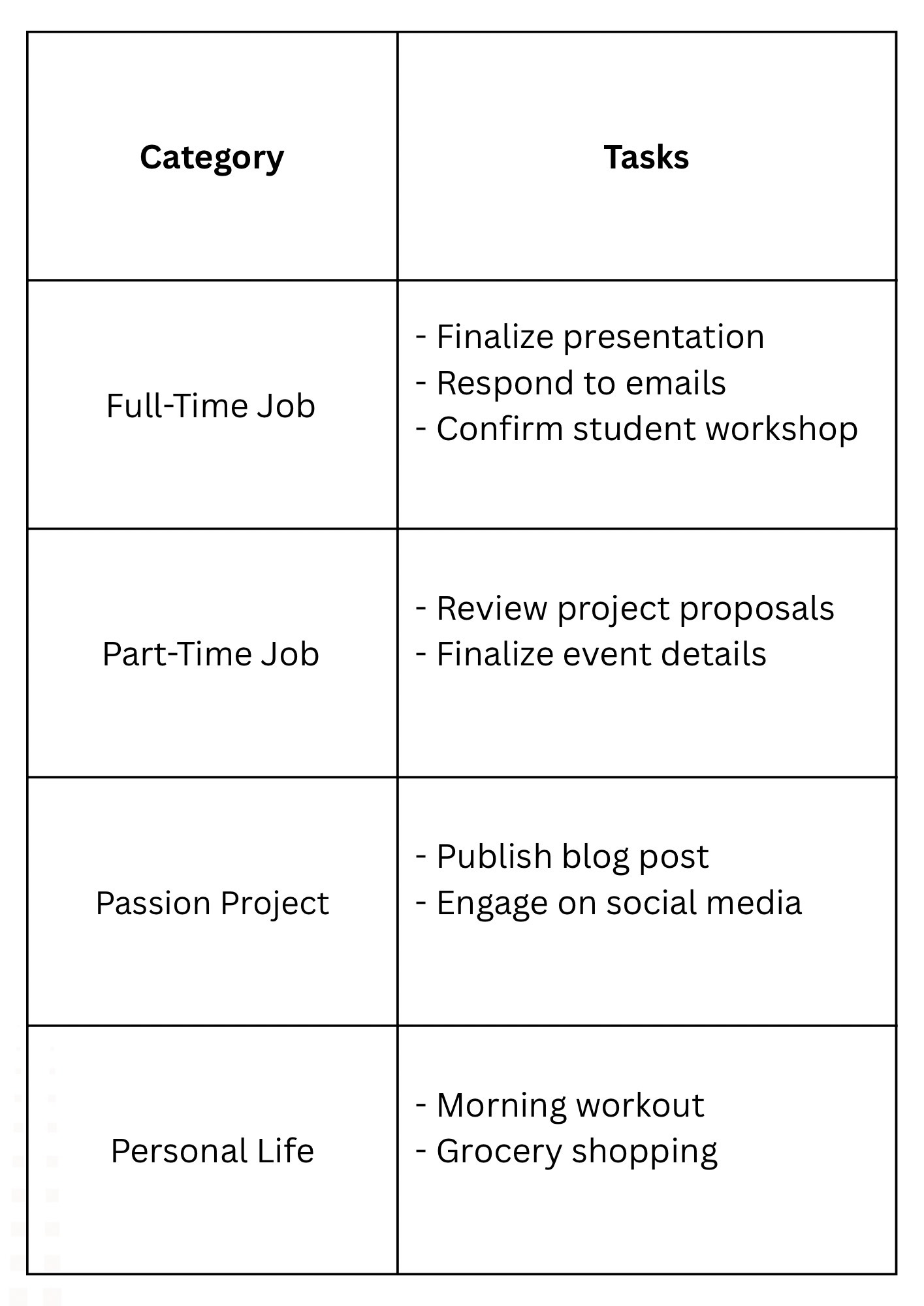There's no such thing as balance, but striving for it remains my perpetual New Year's resolution.
This guide, inspired by the video “How I Plan My Week as a Multi-Passionate / Multi-Hyphenate Woman” by Christian Mills, breaks down a practical strategy to help you manage your time, reduce stress, and stay productive.
If you’re juggling multiple passions and searching for a system that brings structure without stifling creativity, this method might be exactly what you need.
The Importance of Weekly Planning
Many people feel overwhelmed not because they have too much to do but because they lack a structured system to manage their responsibilities. A well-planned week can:
Reduce stress and mental overload
Provide a clear overview of priorities
Ensure all roles and commitments are accounted for
Help you stay on track with personal and professional goals
Step 1: Identify Your Roles
Before planning your week, identify the different roles you are balancing. In the video, the speaker categorized her commitments into four key areas:
Full-time role (e.g., leadership position at a college)
Part-time role (e.g., coordinator role at a nonprofit)
Passion project or personal business (e.g., leading a women's empowerment community)
Personal life (e.g., self-care, family, health, hobbies)
You may have additional categories, The key is to recognize what areas require your attention each week.
Step 2: Create a Weekly Overview Chart
Once your roles are identified, create a weekly chart to structure your planning. Here’s how:
At the top of your page, write the week’s date (e.g., Week of March 17th).
Draw four columns, each labeled with a category (e.g., Full-time job, Part-time job, Passion Project, Personal Life).
This chart provides a visual breakdown of responsibilities, making it easier to distribute your tasks effectively.
Step 3: Review Your Calendar & List Commitments
Before adding new tasks, take time to review your existing commitments—this is the foundation of effective weekly planning.
Start with:
Meetings & Scheduled Events
Check your work calendar, personal calendar, and any project management tools. Note down essential meetings, deadlines, or scheduled sessions.
Recurring Responsibilities
List ongoing commitments that come with your roles—especially your job. If you're being paid for it, it deserves priority and clarity. Think: weekly check-ins, team meetings, scheduled content uploads, or any non-negotiables.
Personal Commitments
Include doctor’s appointments, social events, rest blocks, or non-work-related tasks that matter for your well-being.
Example:
If you have recurring meetings on Tuesday and Thursday for your full-time role, block those off first. That way, you’re building your week around what’s already set, not double-booking or stretching yourself too thin.
Step 4: Assign Weekly Tasks by Category
After listing meetings and commitments, add specific tasks for each role. Consider:
Work-related tasks – Preparing reports, attending training, responding to emails
Side project goals – Content creation, product development, client outreach
Self-care & personal growth – Exercise, reading, journaling, creative projects
Example of a completed chart:
Week of March 17th Full-Time Job Part-Time Job Passion Project Personal Life Monday Prepare reports Schedule meetings Write blog post Gym session Tuesday Team meeting Grant research Social media strategy Dinner with friends Wednesday Review proposals Event planning Webinar hosting Therapy session Thursday Conference call Partnership outreach Newsletter draft Yoga class Friday Budget review Community engagement Content filming Solo lunch outing
Step 5: Break Down Daily Tasks
Now that your weekly plan is in place, it’s time to translate it into daily action steps. This keeps you focused and intentional—without the overwhelm.
I personally swear by tools like ASANA to help me stay organized and on track, but pen and paper works just as well.
Here’s how to structure your daily plan:
Write the day and date at the top of your page
Redraw your columns for each active category
Prioritize 3–5 key tasks per section—enough to stay productive without overloading
Example; Monday, March 18th
Bonus Tip: Cross off tasks as you complete them to track progress and stay motivated!
Step 6: Color Code Your Calendar
For an extra layer of organization, use color-coding to distinguish tasks on your digital or paper calendar:
Work tasks – Green
Personal life – Blue
Side projects – Yellow
Appointments & events – Red
This method makes it easy to quickly glance at your schedule and see where your time is allocated.
Step 7: Give Yourself Grace & Adjust as Needed
Even the best-laid plans can be interrupted and that’s okay. Life happens, priorities shift, and energy levels fluctuate. What matters most is how you respond.
Rearranging tasks if urgent matters arise
Recognizing when to rest instead of pushing through exhaustion
Moving unfinished tasks to the next day if needed
Planning should reduce stress, not add to it. Use this method as a guide, but allow yourself grace to adjust.
Wishing you good luck—and a better, brighter second half of the year.
Your Sister In Success,
B.












